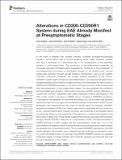Por favor, use este identificador para citar o enlazar a este item:
http://hdl.handle.net/10261/153080COMPARTIR / EXPORTAR:
 SHARE SHARE
 CORE
BASE CORE
BASE
|
|
| Visualizar otros formatos: MARC | Dublin Core | RDF | ORE | MODS | METS | DIDL | DATACITE | |

| Título: | Alterations in CD200-CD200R1 System during EAE Already Manifest at Presymptomatic Stages |
Autor: | Valente, Tony; Serratosa, Joan CSIC ORCID CVN; Perpiñá, Unai CSIC ORCID; Saura, Josep CSIC ORCID; Solà, Carme CSIC ORCID | Fecha de publicación: | 4-may-2017 | Editor: | Frontiers Media | Citación: | Front. Cell. Neurosci. 11: 129 (2017) | Resumen: | In the brain of patients with multiple sclerosis, activated microglia/macrophages appear in active lesions and in normal appearing white matter. However, whether they play a beneficial or a detrimental role in the development of the pathology remains a controversial issue. The production of pro-inflammatory molecules by chronically activated microglial cells is suggested to contribute to the progression of neurodegenerative processes in neurological disease. In the healthy brain, neurons control glial activation through several inhibitory mechanisms, such as the CD200-CD200R1 interaction. Therefore, we studied whether alterations in the CD200-CD200R1 system might underlie the neuroinflammation in an experimental autoimmune encephalomyelitis (EAE) model of multiple sclerosis. We determined the time course of CD200 and CD200R1 expression in the brain and spinal cord of an EAE mouse model from presymptomatic to late symptomatic stages. We also assessed the correlation with associated glial activation, inflammatory response and EAE severity. Alterations in CD200 and CD200R1 expression were mainly observed in spinal cord regions in the EAE model, mostly a decrease in CD200 and an increase in CD200R1 expression. A decrease in the expression of the mRNA encoding a full CD200 protein was detected before the onset of clinical signs, and remained thereafter. A decrease in CD200 protein expression was observed from the onset of clinical signs. By contrast, CD200R1 expression increased at EAE onset, when a glial reaction associated with the production of pro- and anti-inflammatory markers occurred, and continued to be elevated during the pathology. Moreover, the magnitude of the alterations correlated with severity of the EAE mainly in spinal cord. These results suggest that neuronal-microglial communication through CD200-CD200R1 interaction is compromised in EAE. The early decreases in CD200 expression in EAE suggest that this downregulation might also occur in the initial phases of multiple sclerosis, and that this early neuronal dysfunction might facilitate the development of neuroinflammation. The increased CD200R1 expression in the EAE model highlights the potential use of targeted agonist molecules as therapeutic tools to control neuroinflammation. In summary, the CD200-CD200R1 system is a potential therapeutic target in multiple sclerosis, and CD200R1 agonists are molecules that may be worth developing in this context. | Versión del editor: | http://dx.doi.org/10.3389/fncel.2017.00129 | URI: | http://hdl.handle.net/10261/153080 | DOI: | 10.3389/fncel.2017.00129 | ISSN: | 1662-5102 |
| Aparece en las colecciones: | (IIBB) Artículos |
Ficheros en este ítem:
| Fichero | Descripción | Tamaño | Formato | |
|---|---|---|---|---|
| Alterations in CD200-CD200R1 System.pdf | 6,5 MB | Adobe PDF |  Visualizar/Abrir |
CORE Recommender
PubMed Central
Citations
11
checked on 24-abr-2024
SCOPUSTM
Citations
19
checked on 20-abr-2024
WEB OF SCIENCETM
Citations
18
checked on 24-feb-2024
Page view(s)
301
checked on 24-abr-2024
Download(s)
198
checked on 24-abr-2024

